Why you can trust TechRadar
This is where the Asus Zenfone 2 shines for its price. Its spec sheet includes an Intel processor, when other major phones boast popular Qualcomm Snapdragon chips at their heart.
The Intel Atom Z3580 quad-core processor is clocked at 2.3GHz, meaning it's fast enough to handle games and multitasking along with its PowerVR Series 6 G6430 GPU.
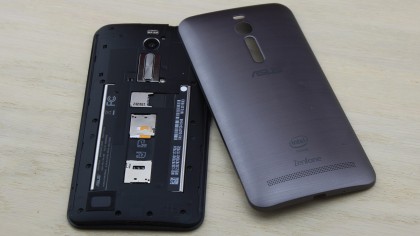
Asus gave its phone some nice overhead when it comes to memory, with 4GB of RAM when almost every other phone tops out at 3GB of memory. The cheaper variant, also a quad-core, is slower at 1.8GHz and 2GB.
Intel's 2.3GHz quad-core chip and 4GB of RAM combination doesn't make the new Asus phone the fastest – far from it. But it's competitive for its mid-range price by beating almost all of last year's top phones.
Its Geekbench 3 multi-core score of 2,851 outpaces the Galaxy S5, HTC One M8 and OnePlus One, and is just shy of the performance of the Moto X 2014, which hasn't been refreshed yet.
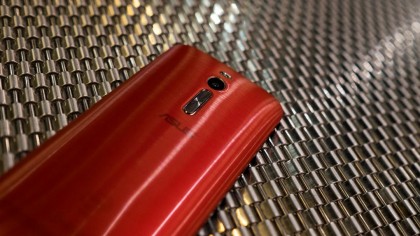
It does trail this year's flagships, though. Google's Nexus 6 averaged a 2,986, HTC One M9 scored a 3,005 and the Samsung Galaxy S6 pulled away from the pack with a 4,100 score.
Zenfone 2's performance is fairly smooth, save for its long 45-second boot up time. And, with 64GB of internal storage (16GB for the cheaper model) and a microSD card slot under the back cover, it's certainly well equipped for your photos and music.
Call quality, likewise, remained excellent. Though, again, the speaker shouts out of the back of the phone, like too many other smartphones that fail to avoid this pet peeve again and again.
Android 5.0 Lollipop and apps
The Zenfone 2 is a cheap way to upgrade to Android 5.0 Lollipop, if you're stuck with a phone that hasn't received (or will not get) Google's new operating system update yet.
Upon booting up the phone, you wouldn't really recognize the Material Design theme that the search engine giant created for its Nexus 6 and other stock Android phones. This isn't a pure Android phone.
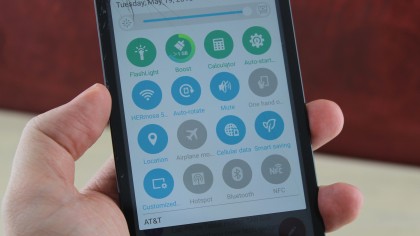
Instead, it has Asus's ZenUI overlay that cranks up the customization for a more complicated layout, but one that people who root Android phones will appreciate.
The quick settings drop down panel, for example, is chock full of options arranged in a 4 x 4 grid. It's just two swipes down and one button press to turn on the flashlight or airplane mode.
Best of all, the grid of 12 quick settings can be customized to your liking. Not all Android phones let you tinker with this panel, which is one of many reasons why people end up rooting their phones.
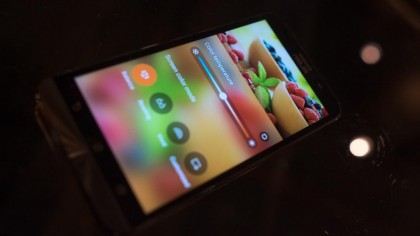
Zenfone 2 gives users control over icon packages, themes, scroll effects between panels, folder icon sizes and styles – heck, even app title font sizes and colors.
There's even an pre-loaded app called Splendid that let's you change the color temperature of the phone display ever so slightly, as if it were a TV screen with customizable controls.
There's an "Easy Mode" within the main settings menu for everyone who doesn't want all of the complexity of ZenUI. But really, that's its killer app – thanks to ZenUI, there's less of a reason to root this phone.
ZenUI apps
Asus also includes over a dozen homegrown apps in addition to the more familiar Google apps that it's forced to carry with the Android-based Zenfone 2.

Notably, File Manager provides control over the internal storage and microSD card files, Do It Later supplies an app-integrated task list and flashlight beams out an SOS help signal – just in case.
More fine-tuning of this Android device can be found in Asus's other ZenUI apps, like Auto-start Manager, Power Saver and Autowizard.
There are also plenty of repeats of what Google already provides: a web browser, gallery app, contacts list, calendar, clock, music, weather, calculator, notes and web storage.
That's where I ran into a real problem with the ZenUI apps: They can't be uninstalled from the cluttered Android app launcher menu. They can be hidden or put into smart groups, but wiping them from the interface remains impossible outside of rooting.
Calls and messages
I normally default to Hangouts and don't mention the phone call app unless there's something truly novel, and on the Zenfone 2, both messages and the dialer are special.
Both incorporate the dual micro SIM cards into their interface, making it easy to switch back and forth between calling and sending messages between phone numbers.
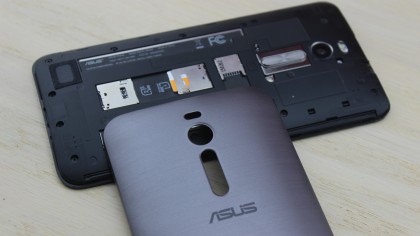
It's fairly seamless to use when traveling abroad. I can easily imagine eating up cheap data with an international number via SIM 1, but keeping my phone number intact for calls and texts via SIM 2, which can only handle voice and texts.
While there's no way to seamlessly transition from a phone call to a video call, a feature I do appreciate on the more locked-down iOS within the iPhone 6 Plus, there are some extra buttons when on a call.
Namely, being able to record a phone call is handy for interviews, or if you're trying to point out horrible customer service to the world. Sending files to the contact while they're on the line is also a button integrated into this screen.
Current page: Specs, performance and software
Prev Page Introduction, design and display Next Page Camera and battery life
